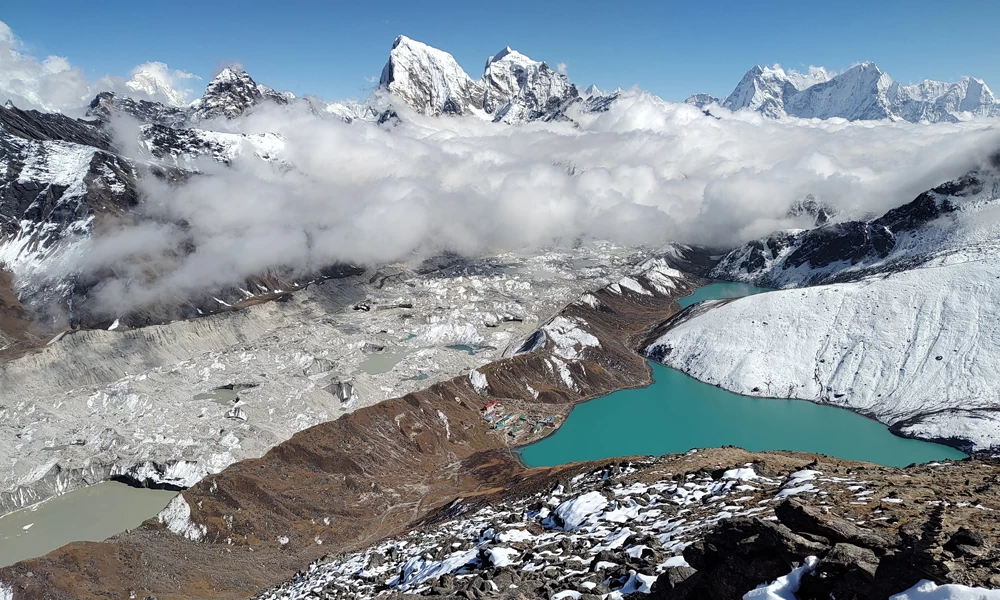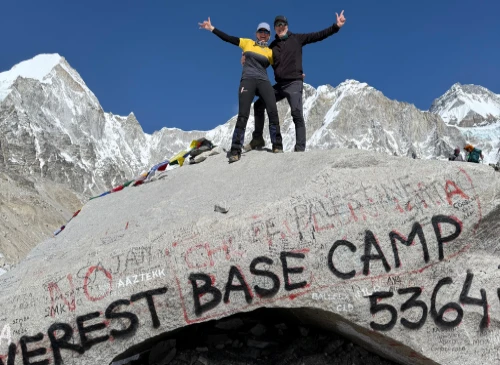Difficulty level of Everest Gokyo Trek Lobuche Peak Climbing
The Everest Gokyo Trek Lobuche Peak Climbing is moderately challenging in its toughness, and it is thus recommended for trekkers who have previous experience trekking on high-altitude terrains. The trek is physically demanding, and the days are relatively long, where one walks for 6-8 hours, demanding steep ascending, rocky terrains and sometimes crossing high altitude passes such as the Cho La Pass (5,420m). The trekking altitude ranges in regions over 5000 meters, and hence, altitude affects the availability of oxygen; one needs to acclimatize while on the trek.
The hardest part of trekking is to climb Lobuche Peak, a technical trek that requires mountaineering tools, including ropes, crampons, and ice axes. The difficulty involved in Lobuche Peak comes with steep icy slopes and the altitude, with the peak sharing altitude of 6,119m. However, it is one of the trekking peaks, and one still needs some level of fitness, determination, and at least some mountaineering experience to make the trek successful.
How to prepare for the trek?
When preparing for the Everest Gokyo Trek Lobuche Peak Climbing, there is a need to make significant physical, mental, and logistical preparations. Here’s how you can prepare:
- Physical Fitness: It is suggested that one must begin a training regimen at least three to four months before the trek. Emphasis on increasing stamina, muscle strength, and cardiovascular capacity. Other exercises that can be useful for the simulation of trekking conditions include hill walking, walking on irregularities, stair climbing, and cycling. Also, including strength exercises targeting the lower body and even the abdomen will help carry the bag and handle steep terrains. Do not also forget your cardio sessions, such as running or swimming, with a view of strengthening your lungs for high altitude.
- Acclimatization and Altitude Readiness: Many people get mountain sickness when trekking at high altitudes, hence the need to rest in between to avoid getting sick. You may find it helpful to do training walks at high altitudes, or take weekend outings to mountainous country to ‘acclimatise’. Low-impact exercises like deep breathing or yoga can also assist one in acclimatizing himself to lower oxygen concentrations. Before the journey, participants should mentally prepare for being outside, possibly in unpleasant weather, undertaking several daily activities through trekking.
- Gear and Equipment: Get proper trekking equipment, preferably good hiking shoes and waterproofs, and some warm layers, especially if you are heading out later in the year. For the Lobuche Peak climbing, you must have technical gear such as crampons, ice axes, harnesses, ropes, etc. However, such gear can sometimes be arranged to be hired through the trekking company. Ensure your backpack contains things such as extra water bottles, some snacks, a first aid kit, and, and poles for support.
- Mental Preparation: Expect to work long hours, endure unpredictable weather, and face multiple tasks while trekking and climbing Lobuche. Writing this article can also encourage trekkers and other users to read it and get motivated through others’ experiences or watching the trek and summiting.
- Health and Medical Preparations: It is advisable to seek a medical checkup from a doctor before undertaking the trek to check your fitness level. Basic essentials to carry include altitude sickness drugs such as Diamox and a personal first aid kit with items such as bandages, painkillers, and prescribed drugs. Make certain that your insurance plan covers travel to high altitudes and mountaineering.
Food and Accommodation during the Everest Gokyo Trek Lobuche Peak Climbing
While on the Everest Gokyo Trek Lobuche Peak Climbing, some of the delicious foods to be enjoyed by the trekker are very comfortable, but the accommodation is quite essential. Trekking in Nepal is done in teahouse trekking, where meals and overnight stays are taken in local lodges, popularly called teahouses, providing simple beds with shared washing facilities. What was interesting is that in the even more secluded places, such as around Lobuche or at even greater altitudes, people offer rooms not as comfortable as in Gau, but they are warm and ensure protection from the extreme conditions of the weather. Also, as you move up, the lodges become slightly primitive; this is especially true near the base of the Lobuche Peak, where camping might be required for the summit.
As for the meals, the teahouses offer a range of foods to choose from; however, the main staples include dal bhat (soup made of lentils and rice), noodles, potatoes, soups, and different forms of breakfasts, ranging from pasta to pancakes or eggs, following the western way of meal preparation. During the Gokyo Valley, you get a taste of the traditional Sherpa food, and as you climb Lobuche, the food is more or less calorie-intense for high-altitude trekking. Drinking water is available, though using water purification tablets OR purchasing bottled water when ascending high altitudes is recommended.
Permits required for the Everest Gokyo Trek Lobuche Peak Climbing
To complete the Everest Gokyo Trek Lobuche Peak Climbing, trekkers must obtain several licenses to access the region and undertake the climb. Here’s what you need:
- Sagarmatha National Park Entry Permit: This permit is required for those who want to visit the Sagarmatha National Park, a UNESCO World Heritage site for the region of Everest. This can be collected at the Nepal Tourism Board in Kathmandu or the park entry point in Monjo.
- Khumbu Pasang Lhamu Rural Municipality Permit: This local permit, which has replaced the earlier TIMS card for the Everest region, is needed for trekking in the Khumbu area. It can be bought in Lukla or from a counter at a coffee shop in Monjo.
- Lobuche Peak Climbing Permit: To climb Lobuche Peak, one must receive a special climbing permit from the Nepal Mountaineering Association. The cost of this permit varies depending on the season: it tends to be more increased in the spring and lower in the autumn and winter.
All these permits are necessary. If you miss them, you will be charged or restricted from finishing your trek or climbing. During your treks, most trekking agencies, including the Everest Gokyo Trek Lobuche Peak Climbing, will arrange and sort out the required permits on your behalf.
Guides and porter service
Everest Gokyo Trek Lobuche Peak Climbing is supported by our experienced guide and porter to make your journeys safe, fun, and served. The people who are our guides are very professional, generally knowledgeable, and very familiar with trails and climbs of the Everest zone. Hailing from the country, they are knowledgeable in cultural practices, ecology, and dealing with altitude issues; thus, they are helpful companions all through the trek and climb. They will show the main challenging tracks to overcome, assist with the acclimatization, and offer information about the area.
You will meet our porters during the trek, and they are essential in making your trek successful; however, our porters are restricted to carrying a load of 20 kg per porter. One porter is assigned two trekkers to make sure your belongings are transported securely and comfortably for the trekkers. We take good care of our porters and guides; their meals, accommodation, and insurance are paid from the day of the trekking to the day of our departure. This includes a decent place of abode, a balanced diet, medical check-ups, and overall health care provided for the health and safety of the child. We do this to ensure that our guides and porters are treated fairly and rightfully so that they may, in turn, give you their best in the trek and climb.
Through proper and safe trekking practices, it promotes the sustainable tourism concept while offering the trekkers the finest level of services on the Everest Gokyo Trek Lobuche Peak Climbing.
Travel insurance during the Everest Gokyo Trek Lobuche Peak Climbing
For the Everest Gokyo Trek Lobuche Peak Climbing, it is mandatory to have full travel insurance. Your insurance must have provisions for trekking at high altitudes (up to 6194 m) and mountaineering, medical conditions, helicopter evacuations, and trip interruption/cancellation. It is also essential that the policy also has provisions for accidental and injury-relatedinjury-related incidents that may happen during the climbing of Lobuche or while trekking in other relatively isolated areas. As highlighted in this article, insurance policies that provide cover against altitude sicknesses, evacuation, and other things that are a consequence of altitude are critical so that as you travel, you do not have to worry about any mishap. It is, therefore, essential to ensure that your provider has incorporated these particular activities in the policy.
Altitude sickness
Altitude sickness is a condition that occurs whenever the amount of oxygen available in the air is too low to support normal physical activity. It is commonly known as Acute Mountain Sickness (AMS). Interference can be moderate, like headache or nausea, or severe, and include breathlessness or confusion. This usually occurs in trekkers who hike at an altitude of 2500m and above; however, failure to treat the condition will worsen it.
Prevention of altitude sickness:
- Ascend Gradually: Gradually raise the altitude so that the human body can gradually get used to decreased oxygen concentration. If you are above 3,000 meters, do not climb more than 300-500 meters a day.
- Stay Hydrated: Make sure you drink enough water. This will help your body handle the region's altitude.
- Avoid Alcohol: Avoid alcohol and sleeping pills since they affect the symptoms and hamper the acclimatization process.
- Eat Lightly: Ensure that you eat more carbohydrates to supply energy and for acclimatization.
- Rest Appropriately: Pamper yourself with adequate rest; you should not overexert yourself, particularly in the initial days of the trek.
- Consider Medications: Sup herbal medications like Diamox for altitude sickness as advised by a health care provider to facilitate acclimatization.
- Recognize Symptoms Early: Be aware of the symptoms and descend immediately if you experience severe signs of altitude sickness to prevent complications.
Packing list
Clothing:
- Base Layers: Moisture-wicking thermal underclothes (top and bottom).
- Mid Layers: Fleece jacket and thermal mid-layers for insulation.
- Outer Layers: Waterproof and windproof jacket and pants.
- Insulating Jacket: Down or synthetic jacket for cold temperatures.
- Trekking Pants: Quick-dry and durable pants.
- Climbing Pants: Technical climbing pants for Lobuche Peak.
- Hats: a Sun hat for daytime and a warm hat for cold conditions.
- Gloves: Lightweight gloves for trekking and insulated, waterproof gloves for climbing.
- Socks: Several pairs of moisture-wicking trekking socks, including some thermal pairs.
Footwear:
- Trekking Boots: Waterproof, sturdy, and broken-in trekking boots.
- Climbing Boots: Insulated and crampon-compatible boots for Lobuche Peak.
- Camp Shoes: Lightweight sandals or shoes for use at camp.
Climbing Gear:
- Crampons: For icy and snow-covered terrain.
- Ice Axe: Essential for climbing Lobuche Peak.
- Harness: A climbing harness for safety on steep sections.
- Ropes: These are generally provided by your climbing operator, but check in advance.
- Carabiners and Belay Device: If provided by someone other than your guide.
Personal Gear:
- Backpack: A trekking backpack (30-40 liters) and a more giant duffel bag for porters.
- Sleeping Bag: Rated for cold temperatures (down to -20°C/-4°F).
- Sleeping Pad: This is for added insulation and comfort.
- Trekking Poles: Adjustable and lightweight.
- Headlamp: With extra batteries.
- Sunglasses: UV-protective for high-altitude glare.
- Water Bottles: Two or three bottles (1-2 liters each) and a water purifier or purification tablets.
- First Aid Kit: Personal medications, blister treatments, and basic medical supplies.
- Sun Protection: Sunscreen, lip balm with SPF, and a wide-brimmed hat.
Miscellaneous:
- Camera and Batteries: This is used to capture the stunning scenery.
- Travel Documents: Passport, permits, insurance, and any necessary paperwork.
- Snacks: High-energy snacks for the trek and climb.
- Personal Hygiene Items: Biodegradable soap, toothbrush, and other toiletries.
This packing list covers the essentials needed for a successful and comfortable journey on the Everest Gokyo Trek Lobuche Peak Climbing. Ensure all items are checked and packed well in advance to be fully prepared for the adventure.






